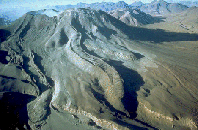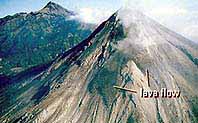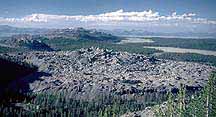

Whereas basalt forms a'a and pahoehoe surface forms, andesite generally produces blocky lava. Here, the surface contains smooth-sided, angular fragments (blocks) that are not as splintery or vesicular as a'a lava fragments. The blocky nature of these flows is attributed to the higher viscosity of andesite. These viscous lavas have relatively high aspect ratios (thickness/area), generally > 1/100, and some are thick enough to form as lava domes. Andesite commonly erupts from stratovolcanoes, where they form small-volume flows that typically advance only short distances down the flanks of a volcano. The two examples shown here are short andesite flows advancing down the slope of the Lascar volcano in Chile, and the Colima volcano in Mexico.
 |
 |
|
|
|
Although detached blocks occur on the tops of andesite flows, the flow interior is composed of massive lava which grades downward into an autobrecciated (self-fragmented) basal layer. The flow moves by the injection of lobes of lava into the collar of blocky rubble that comprises the flow front. The flow-front rubble is then continually overridden by the massive lava core to form the fragmented basal layer of the flow.
With increasing silica (SiO2) content and polymerization, the viscosities of these felsic lavas will increase accordingly. Although dacitic-to-rhyolitic lavas typically erupt from stratovolcanoes, they are not as abundant as andesite lava. Instead, felsic eruptions from stratovolcanoes are more commonly explosive and associated with the generation of tephra and pyroclastic flows. These explosive eruptions are a function of the high viscosities and high gas contents of dacitic and rhyolitic magmas. Such eruptions, however, will often deplete the magma source in dissolved gases. De-gassed magma can then rise to the surface and extrude in a less violent fashion, as dacite to rhyolite lava. These lavas are volumetrically smaller than their pyroclastic counterparts, and typically form after major eruptive events. Viscous dacitic-to-rhyolitic lavas generally ooze out of the volcano's central vent to form symmetrical lava domes. In some cases, however, asymmetric flow down one side of the vent can produce an elongated extrusion, called a coulée or a dome flow. These viscous flows vary from 50 to 500 meters in thickness, and are typically only a few kilometers long. However, some coulées may flow for several kilometers, probably due to high eruption temperatures, which would lower their viscosities (also see western Arabian phonolite coulées - one and two).
 |
 |
|
|
|
In some cases, thick rhyolitic lavas will cool as glassy obsidian flows, as demonstrated by the appropriately named "Obsidian Flow" at the Long Valley caldera, shown in the photo below.
 |
|
|
As demonstrated above, felsic magmas will either (1) erupt explosively to produce extensive deposits of tephra, or (2) nonexplosively to produce degassed, viscous lava (domes, coulees, or obsidian flows) which advance only short distances from their vents. There has been a significant amount of controversy, therefore, over rare rhyolite lavas that appear to occur as large-volume flows (10-100 cubic kilometers).
Most such flows occur near continental hotspots. The best known examples are those associated with (1) the Yellowstone hotspot track near the Idaho-Oregon border, and (2) the Ethiopian hotspot in northeastern Africa. These large-volume felsic volcanic rocks have outcrop, hand specimen, and thin section characteristics typical of lava flows. However, many volcanologists suspect that they are not lava flows at all, but rather rheomorphic ignimbrites. These are densely welded pyroclastic flows of pumice and ash, which were thick and hot enough to flow downslope and obliterate primary pyroclastic structures. They suggest that the original pumice and ash fragments have been streaked out like toffee strands so that the pyroclastic nature of the flow becomes unrecognizable.
Still, other workers are convinced that these voluminous rhyolites are in fact lava flows, and that their extensive distribution can be attributed to their unique position above a continental hotspot. They suggest that the widespread melting of continental crust above the hotspot could generate superheated, low-viscosity melts that would erupt in a fluid fashion to produce voluminous sheets of rhyolitic lava. The controversy is still unresolved.